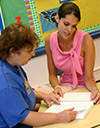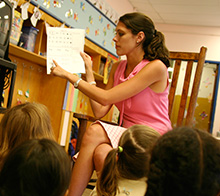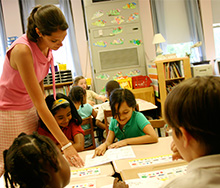How can the teachers at Washington Elementary implement these activities?
Page 7: Train Students
 Before they can effectively implement PALS, the kindergarten and first-grade teachers at Washington Elementary must first ensure that their students are adequately trained. Reviewing the PALS manuals, they learn that the training is divided into multiple sessions, which allows the teachers to gradually introduce their students to the rules, classroom procedures, and peer-mediated activities. They also observe that the training for each grade level is different.
Before they can effectively implement PALS, the kindergarten and first-grade teachers at Washington Elementary must first ensure that their students are adequately trained. Reviewing the PALS manuals, they learn that the training is divided into multiple sessions, which allows the teachers to gradually introduce their students to the rules, classroom procedures, and peer-mediated activities. They also observe that the training for each grade level is different.
K-PALS Training
In the case of K-PALS, training consists of four introductory Sound Play lessons and eight training lessons in which the teacher models the PALS rules, activities, and correction procedures in a whole-group format. Initially, the teacher serves as Coach while the students act as Readers and respond to the Coach’s prompts in unison. Gradually, the teacher allows opportunities for individual students to act as the Coach in this whole-class format. Finally, the students begin to work in pairs, tutoring each other while the teacher monitors and provides corrective feedback. Review the video below to observe a teacher introducing K-PALS procedures to her kindergarten classroom (time: 1:47).
Transcript: K-PALS Training
Teacher: You know what? I’m going to listen for someone who’s doing a really good job to come up and be the coach. Okay? Let’s go together. What sound?
Students: /t/.
Teacher: What sound?
Students: /aaa/.
Teacher: What sound?
Students: /t/.
Teacher: Good job! What sound?
Students: /mmm/.
Teacher: What sound?
Students: /t/.
Teacher: What sound?
Students: (mixture of /t/ and /mmm/.)
Teacher: Stop. You missed a sound. That sound is /t/. What sound?
Students: /t/.
Teacher: Good job! What sound?
Students: /aaa/.
Teacher: What sound?
Students: /mmm/.
Teacher: What sound?
Students: /aaa/.
Teacher: Good job. What sound?
Students: /t/.
Teacher: Good. Now I’m going to look for someone who’s done a really good job to come up and take a turn. Tiara, what are you going to do when you get to a star today? What are you going to say?
Tiara: Great job.
Teacher: Great job! And how about if somebody makes a mistake—how will you help them? What will you say?
Tiara: Stop you missed a sound. That sound is /mmm/.
Teacher: And then you’re going to say, “What sound?”
Tiara: What sound?
Teacher: And you’re going to take them to the very…
Tiara: Beginning.
Teacher: Alright. Tiara, will you come up and take a turn? Let’s start right here.
Tiara: What sound?
Students: /mmm/.
Tiara: What sound?
Students: (mixture of /aaa/ and /tuh/.)
Tiara: Stop. You missed a sound. That sound is /t/.
Teacher: What sound?
Students: /t/.
Teacher: Good job. Go back and…
Tiara: What sound?
Students: /mmm/.
Tiara: What sound?
Students: /t/.
Tiara: What sound?
Students: /aaa/.
Tiara: What sound?
Students: /t/.
Tiara: What sound?
Students: /mmm/.
Tiara: Great job.
Teacher: Excellent, Tiara. Would you color in a smiley face? That’s what we do when we get to the bottom, right? That shows us we did a good job.
First-Grade PALS Training
The first-grade teachers will spend the first two weeks of PALS training their students. These trainings will occur four times each week and last between 15 and 30 minutes. During these two weeks, the students will learn the PALS procedures and how to perform the Sounds and Words activities. Once training is complete and the students have implemented PALS independently for at least eight weeks, the teacher introduces Partner Reading. The training for this activity should occur over two sessions and will take approximately 15 minutes per session.
Training Procedures
The teachers of Washington Elementary decide to train their students during the regularly scheduled reading period. In order to successfully teach their students about PALS, they make sure to:
| 1. Discuss the PALS approach |
 The teachers introduce PALS, highlighting its advantages and benefits. They explicitly explain what the strategy is for, how it is used, and under what circumstances it is effective. In addition, the teachers: The teachers introduce PALS, highlighting its advantages and benefits. They explicitly explain what the strategy is for, how it is used, and under what circumstances it is effective. In addition, the teachers:
Rules that Apply During the Implementation of PALS During a PALS session, the teacher must encourage good behavior and enforce the rules. Although most of the established rules will apply, teachers should keep in mind the four rules recommended by the developers of PALS:
(From Peer-Assisted Learning Strategies: Kindergarten Reading, by D. Fuchs, L. S. Fuchs, A. Thompson, S. Al Otaiba, L. Yen, K. McMaster, N. Yang, E. Svenson, M. Braun, 2002, p. 66. See also: Peer Assisted Learning Strategies: First Grade Reading, by D. Fuchs, L. S. Fuchs, E. Svenson, L. Yen, A. Thompson, K. McMaster, S. Al Otaiba, N. Yang, and M. Braun, 2000, n.p.) |
| 2. Model PALS activities |
 The teachers model the set-up procedures and each reading activity. Additionally, through presentations and role-playing, the teachers: The teachers model the set-up procedures and each reading activity. Additionally, through presentations and role-playing, the teachers:
PALS Set-Up Procedures Any or all of the steps necessary to ensure the successful execution of a PALS session, including but not limited to moving to a partner quickly and quietly, working cooperatively, gathering materials, and following the rules of PALS.
|
| 3. Allow time for guided practice |
 Once the students understand the basic principles of PALS, the teachers allow them to practice what they have learned. During this time, the teachers guide their students through the process as they: Once the students understand the basic principles of PALS, the teachers allow them to practice what they have learned. During this time, the teachers guide their students through the process as they:
Moving to Partners As with any classroom transition, teachers should minimize the amount of time that students are not engaged in academic activity. Teachers may want to use one of the methods below to move students to their assigned partner.
|
| 4. Provide opportunities for independent practice |
 When students have become more familiar with each of the activities, the teachers monitor their practice and provide instructional feedback. They make certain that the students: When students have become more familiar with each of the activities, the teachers monitor their practice and provide instructional feedback. They make certain that the students:
|
Stephanie Johnson describes how she conducts PALS training and how her students respond (time: 0:39).

Stephanie Johnson
Kindergarten teacher, Westwood Elementary School
Bloomington, Minnesota
Transcript: Stephanie Johnson
With the training of the students, they do learn it quite quickly. To train the students, I do it with a partner teacher, or I invite students up to train them on how to be a Reader, how to be a Coach, and we go through a lot of different things on what that’s like to be a Reader or Coach. And so by the time they’re ready to break off with a partner, it is very exciting because they feel it’s something they earned, and all along they know it’s a goal that we’re working towards. It’s not me who’s going to be the Coach anymore. It’ll be one of them, so it’s an exciting process. There’s a lot of rewards that come with that, too, when they feel that independence.